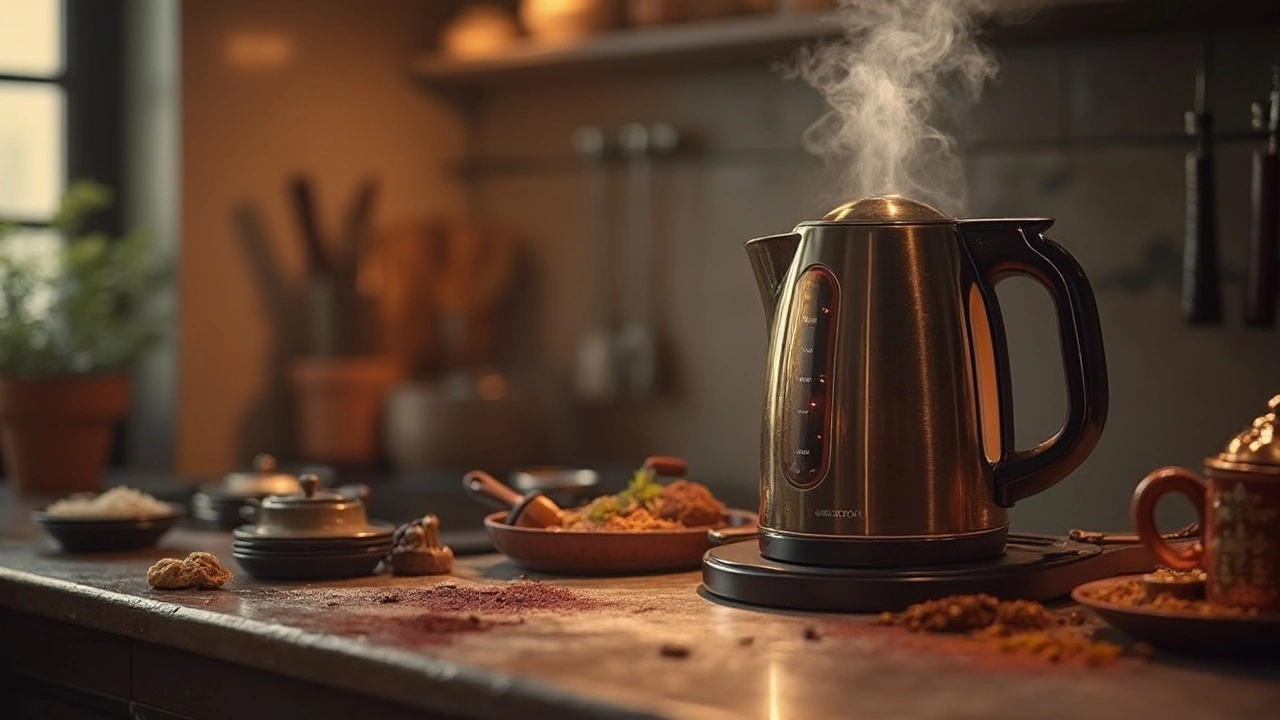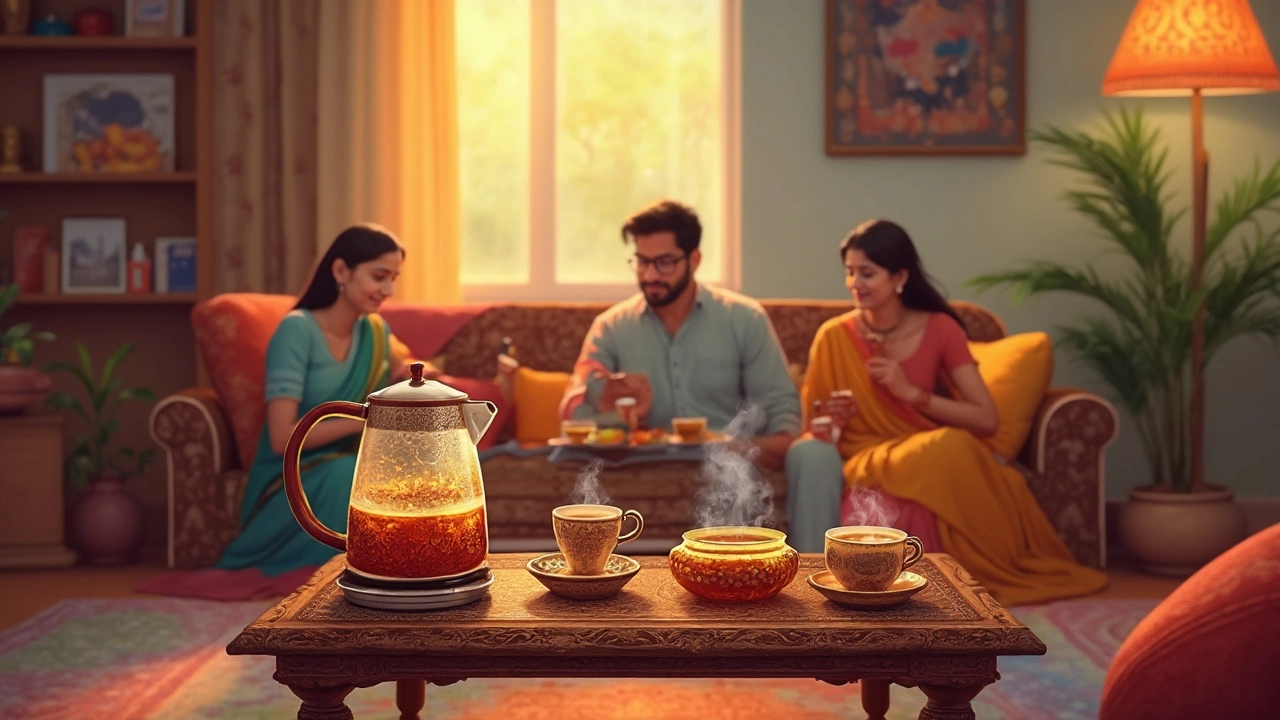
Electric kettles have become the quiet heroes of modern kitchens. Compared to the classic stovetop kettles, they really do pack a punch when it comes to everyday convenience. Ever found yourself in a morning rush, wishing your coffee would just make itself? Well, an electric kettle isn't far off—plug it in, press a button, and boom, boiling water in just a few minutes. No more watching the pot like it's about to reveal the winning lottery numbers.
These nifty gadgets also come with added perks like temperature control. Perfect if you’re a tea enthusiast who knows that not every tea leaves are created equal—some need a gentle touch and lower temperatures to unlock their full flavor.
- Speed and Efficiency
- Temperature Control
- Safety Features
- Energy Usage
- Design and Portability
- Environmental Impact
Speed and Efficiency
When it comes to boiling water, nothing beats an electric kettle for speed and efficiency. On average, an electric kettle can bring water to a boil in just about 3 to 4 minutes. Compare that with a stovetop kettle, which typically takes around 8 to 10 minutes, depending on your stove's power. This might not seem like a huge time saver, but those minutes add up, especially if you're making multiple cups a day.
Electric kettles work by using a metal coil to heat up water. This coil directly transfers energy to the water, making it a much more efficient method than heating the bottom of a pot on a stove. This is a crucial advantage when you're in a hurry and need boiling water, like when you’re trying to whip up a quick meal or hot beverage.
Energy Comparisons
In terms of energy efficiency, electric kettles tend to use less power too. According to various energy studies, they are about 80% efficient while stovetop kettles only reach around 70%. That means more of the electricity you’re paying for is actually going into heating the water, not the air around it.
- Quick mornings: If you’re always racing against the clock in the morning, an electric kettle is your best friend.
- Multiple hot drinks: For families or groups who need several cups at once, the rapid reheating is a lifesaver.
- Recipe-ready: If a recipe calls for boiling water on the fly, having a kettle that can deliver in minutes is invaluable.
Plus, let’s talk design. Modern electric kettles often include features like quiet boil (so you can still get things done without a loud hiss alerting the whole house) and even keep-warm settings so your water stays hot for when you’re ready.
So next time you're thinking about which kettle to go for, remember the impressive speed and efficiency an electric one can offer—those extra minutes can be a real game changer in our daily hustle.
Temperature Control
One of the standout features of electric kettles is their ability to offer precise temperature control. This might not sound like a big deal until you realize that different beverages require different temperatures to truly shine. Tea lovers, listen up! Green tea, for example, is best brewed at around 160-180°F (71-82°C), whereas black tea typically requires a piping 200-212°F (93-100°C). With a stovetop kettle, you're pretty much guessing, but an electric kettle with a temperature setting takes the guesswork away.
These kettles often come with preset temperature options, so you just select the right one for your drink, and you're off to the races. This level of control can seriously change your game if you're particular about your beverage's flavor and aroma.
Let's chat a bit about the temperature settings you might find on some popular models. Many kettles range from 100°F (38°C) to a full boil at 212°F (100°C), giving you flexibility whether you're making a delicate white tea or getting boiling water ready for some pasta.
Moreover, some higher-end electric kettles feature digital displays that allow you to set the exact temperature you want, to the degree. This is perfect if you're a stickler for precision or experimenting with coffee or tea recipes. Trust me, once you get used to this kind of control, you'll wonder how you ever lived without it!
Check out an example of typical settings available on electric kettles:
| Drink Type | Recommended Temperature |
|---|---|
| White Tea | 160°F (71°C) |
| Green Tea | 175°F (80°C) |
| Oolong Tea | 195°F (90°C) |
| Black Tea | 205°F (96°C) |
| Coffee | 200°F (93°C) |
Safety Features
Many people often slack on safety in the kitchen, especially when you’re juggling a million tasks at once. But with an electric kettle, you're getting more than just hot water—you’re getting peace of mind too.
Auto Shut-Off
One of the coolest features is the automatic shut-off. Many electric kettles have sensors that detect when the water has reached its boiling point and turn the kettle off right then and there. This not only saves energy but also prevents the kettle from boiling dry, which in stovetop models, could be a real hazard.
Boil-Dry Protection
This is another handy feature where if there's no water left inside, the kettle just won’t start. You know those days when your brain’s still asleep but you need the coffee? Yeah, it’s like that extra layer of protection keeping you from wrecking your gadget.
Cool-Touch Exterior
Some models come with a cool-touch exterior. Got kids running around, or maybe you’re just a bit clumsy before your morning caffeine hit? Having an exterior that remains cool keeps those accidental burns at bay.
Locking Lids
Steam and hot water can be a risky combo. Many electric kettles feature locking lids that ensure nothing spills out when you’re pouring your third cup of tea just to get through the day.
These thoughtful features not only make electric kettles more user-friendly but also make them a safer choice for families, multi-taskers, or frankly, anyone who enjoys the simplicity of hustle-free boiling.

Energy Usage
When it comes to energy consumption, the electric kettle is often the more efficient choice compared to its stovetop cousin. How so? Well, electric kettles heat water directly with a heating element, causing less heat to escape into the surrounding environment. This direct transfer of energy not only speeds up the boiling process but also means less wasted energy.
Let’s throw some numbers around. While boiling water on a stove with a gas burner might have its charm, it’s not nearly as efficient. Gas stoves typically have an efficiency of about 40%, meaning that 60% of the energy goes elsewhere—usually up in the air, literally. In contrast, electric kettles boast an efficiency rate of around 80-90%.
Why does this matter? It’s all about reducing energy bills and conserving resources. For those keeping a tight budget, the savings one sees over time from using an electric kettle instead of a stovetop can be significant. And hey, who doesn’t like fewer zeros on their electricity bill?
Check out this quick comparison:
| Method | Efficiency |
|---|---|
| Electric Kettle | 80-90% |
| Gas Stove | Approx. 40% |
| Electric Stove | 70% |
Moreover, using an electric kettle also means you don’t have to take part in the anticipatory dance of barely simmering water on a stovetop. Just plug the kettle in, flip the switch, and you can trust it'll get the job done faster and more efficiently. Plus, many electric kettles now have eco-friendly designs, which is a win for Mother Earth too!
Design and Portability
When it comes to design and portability, the modern electric kettle has come a long way from the bulky, plain models of the past. Today's designs cater to both style and function, which means they don't have to hide away in some remote corner of your kitchen. In fact, many electric kettles are now created with sleek, stainless steel finishes or even colorful, retro designs that add personality to any space.
More than just looking good, the portability of an electric kettle is a game-changer. Whether you're someone who travels frequently or just enjoys making tea in different parts of the house, having a cordless option is essential. Most electric kettles detach from their base, making them easy to move around your home or even take on road trips if you have access to an electrical outlet. It's much easier than lugging around a stovetop kettle, right?
For those who appreciate convenience, there's also the efficiency of the compact models. These are perfect for small kitchens, college dorm rooms, or even RVs where space is a premium. You can have your cup of hot water for tea or instant noodles without sacrificing precious counter real estate.
If you're comparison shopping between different models, you might come across some interesting features that could influence your decision. Some electric kettles have see-through bodies, often using glass as the primary material. This not only looks cool but helps you see exactly how much water you're boiling—ideal if you're trying to conserve water or just make one cup.
Here's a quick look at some typical dimensions for electric kettles:
| Type | Dimensions (inches) | Weight (lbs) |
|---|---|---|
| Compact Kettle | 8x6x9 | 1.5 |
| Standard Kettle | 10x8x12 | 2.5 |
| Glass Kettle | 9x7x11 | 3 |
Ultimately, the versatility in design and portability makes the electric kettle a worthy contender in the battle against stovetop kettles. With all these features, you'd be hard-pressed to find a reason not to keep one handy in any living situation.
Environmental Impact
When it comes to the planet, every little bit helps, right? That's where electric kettles might score some points. Compared to their stovetop counterparts, electric kettles are often more energy efficient. They use less electricity to heat the same amount of water, which is a win-win for both your power bill and Mother Earth.
Let’s consider the carbon footprint. A typical stovetop kettle requires more energy because it heats the entire surface of the stovetop, not just the water inside the kettle. So, every time you brew a cup of tea with a stovetop kettle, you're using more resources than necessary. In comparison, an electric kettle heats the water directly, minimizing wasted energy.
If you’re wondering about energy usage rates, here's something interesting. A recent study showed that electric kettles consume around 0.04 kWh to boil a liter of water, compared to 0.11 kWh using a gas stovetop. That's more than twice the energy savings!
What about eco-friendly designs? Many electric kettle manufacturers are catching on to the sustainable trend. You can now find models made with environmentally conscious materials, like recycled stainless steel or BPA-free plastic—good for the environment and safe for your family.
Of course, we can’t ignore the electronic waste factor. It's crucial to dispose of old electric kettles properly. Many manufacturers and communities offer recycling programs. If you find your kettle no longer serving its purpose, opt for these programs instead of sending it to a landfill. A little extra effort goes a long way in reducing environmental impact.